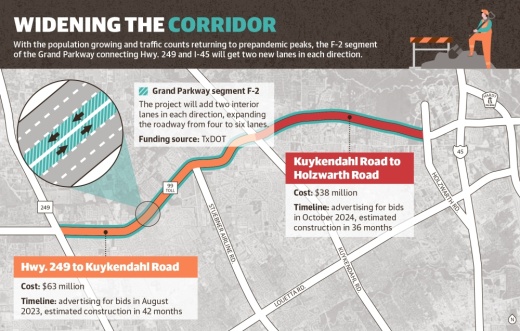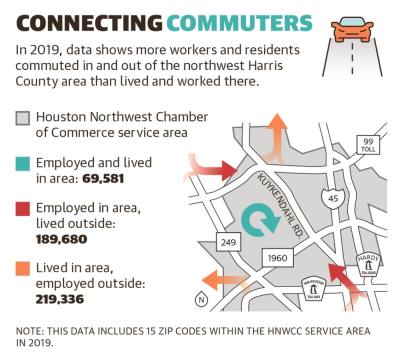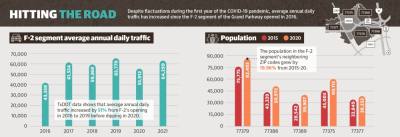TxDOT Public Information Officer Danny Perez told Community Impact in an email the agency will hold a public meeting in April for two projects that will widen the tollway from four to six lanes from Hwy. 249 to Holzwarth Road and cost a combined $108 million.
TxDOT officials confirmed one widening will take place from Hwy. 249 to Kuykendahl Road, costing $63 million with bids to be held in August and an estimated construction time of 42 months. The other project will span between Kuykendahl and Holzwarth roads, costing $45 million with an estimated construction time of three years. The Kuykendahl-Holzwarth widening will go out for bids in October 2024.
Perez said the tollway’s four existing lanes will be kept in operation during the project, and the new lanes—one in each direction—will be expanded inward, reducing the impact construction will have on the surrounding area.
Organizations representing business interests in the area have discussed the need for the highway’s expansion. Marlisa Briggs, the president of the North Houston Association and a business interest representative on the Houston-Galveston Area Council, said she believes growth in north Harris County means a greater need for widening.
“There’s lots of new communities,” Briggs said. “There are lots of new developments and activities.”
Meanwhile, Bobby Lieb, the president of the Houston Northwest Chamber of Commerce, pointed to increasing residential and commercial development near Tomball and I-45 respectively, that led to greater use of the highway.
“This is a relatively new road, and it’s already needed to be widened,” Lieb said. “We’ve got the Tomball area for the residential [growth], and some commercial, plus you have the growth of City Place and Springwoods Village. [The Grand Parkway] is a link between commuters living in the Tomball and Klein area commuting east.”
Timing of expansion
According to Perez, the Grand Parkway’s expansions are controlled by a 2009 market valuation waiver agreement signed by TxDOT and the seven counties—Harris, Montgomery, Brazoria, Fort Bend, Chambers, Liberty and Galveston—the highway runs through. Specific traffic volume thresholds must be met for the highway to provide an adequate level of service, he said.
"The current widening to six lanes is projected to be adequate for current planning horizons as represented by the [Houston-Galveston Area Council’s] 2045 Regional Transportation Plan,” Perez said.
TxDOT data shows average annual daily traffic increased by more than 50% from F-2’s opening in 2016 to 2019—increasing from 43,358 to 65,779 in that timespan. Although 2020—the first year of the COVID-19 pandemic—saw a decrease to 55,912, 2021 saw numbers jump back to 64,299.
Briggs said she believes it had been “impossible to predict” the growth rate reaching the threshold for expansion.
“It was obvious that there was the need for an expansion and obviously the need for the Grand Parkway in the first place,” she said. “But I don’t think anyone predicted how fast the area would grow [since F-2’s opening].”
Adam Beckom, transportation and project programming manager at the H-GAC, said the Houston area in general had grown “at a fairly decent pace” in the past five years.
“Along with this growth, regional travel patterns and vehicular traffic have grown and at a higher rate than the demographic growth,” he said.
Beckom added H-GAC staff is unsure about how growth would affect the conditions laid out in the 2009 waiver, and more time would be needed to determine whether the Grand Parkway will reach traffic counts that require further expansions.
Perez did not rule out the possibility of future expansions to the highway as the waiver agreement requires the state to maintain a specific level of service. TxDOT was able to verify a document Community Impact obtained as the 2009 waiver, but the document did not discuss specific conditions needed to trigger expansions of the highway.
“The level of service criteria applies to the entire Grand Parkway system, and future widenings could be possible, based on traffic volumes, to maintain a specific level of service,” Perez said.
Driving traffic, growth
Lieb cited major employers in the City Place development as a contributing factor to the increase in traffic on the F-2 segment. He specifically highlighted Hewlett Packard Enterprise’s global headquarters move to the campus—announced in 2020 and opening in 2022—as one of the employment developments on the Grand Parkway corridor.
However, Lieb also cited HNWCC research showing workers in northwest Houston and unincorporated Harris County often did not relocate their residences to be nearer to their jobs. The chamber’s report showed in 2019, 63,581 workers both lived and worked in between Hwy. 249 and I-45, compared to 189,680 employed in that area who lived elsewhere and 219,336 workers who lived in the area but worked elsewhere.
According to five-year estimates from the U.S. Census Bureau’s American Community Survey, the combined population of five ZIP codes surrounding the Grand Parkway—77379, 77388, 77389, 77375 and 77377—grew 19.96% from 2015-20, increasing from 226,508 to 271,720.
“When you have that kind of residential growth happening on that west side, you’re bound to get high levels of congestion [from workers] commuting to their traditional places of work,” Lieb said.
Briggs noted ExxonMobil’s January move of its corporate headquarters to City Place as a factor centering employment; however, she also highlighted residential development closer to the Tomball area that established a “solid commuter base.”
“With all of those big companies comes all of the folks that they do business with; they want to locate close to where their colleagues are,” Briggs said.
Andrew Giammalva, the project manager of City Place developer CDC Houston, called the completion of the F-2 segment a “transformational moment” for City Place but said the developers did not consider expansion work “urgent.”
“We don’t see any widening work as a concern, nor do we see it as urgent but certainly hope that any future road work would continue to enhance connections and traffic flow, further supporting thoughtful area growth,” Giammalva said in a statement to Community Impact.
In addition to its corporate headquarters, City Place is also home to two single-family housing communities and three multifamily communities. CDC Houston confirmed to Community Impact in 2021 that it was planning 600 new single- and multifamily housing units for a new 2,000-acre master-planned community by 2023.
Future expansion
The F-2 segment was last re-evaluated in terms of environmental impact in 2012, well before the highway’s opening in 2016. Perez said the new projects will receive their own environmental impact statements due to the age of the previous document, but he was unable to provide a timeline until after the April public meeting.
Perez added TxDOT has received concerns from the public about noise from the tollway, and the project will present the agency an opportunity to investigate noise barriers.
When asked what he was looking forward to hearing from the planning meeting, Lieb said he wanted to know the agency’s plans for surrounding feeder roads during the construction process.
“I think it would be good to know what the service level will be when [the expansion] is finished,” Lieb said. “How long does TxDOT expect that expansion to provide good service levels?”







